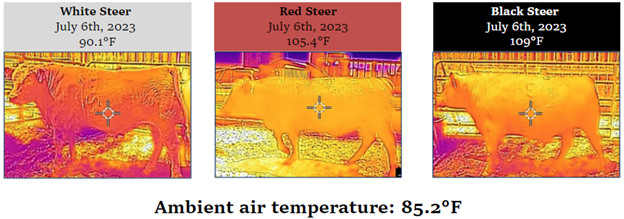Impact of Environmental Extremes on Cattle: The Role of Hide Color
Katie Friede, Research Associate and M.S. Student, Northern Ag Research Center
Download a pdf of this article.
Given that the beef cattle industry utilizes a diverse range of nutritional inputs and animal phenotypes across various geographies and climates, it is crucial to understand how cattle interact with their environments. Furthering our understanding of how cattle adapt to unique environments can enhance the economic viability of livestock production systems. As cattle are exposed to both hot and cold environmental extremes, there can be significant impacts on cattle health, welfare, and productivity.
Cold weather can cause an increase in energy expenditure to maintain a stable internal body temperature. This can result in decreased body weight and gain, which can lead to significant impacts on metabolic processes, including reduced digestive efficiency. Although it is estimated that there is roughly a 1% rise in energy requirements for cattle for every degree below 32°F, diet digestibility in ruminants decrease by 0.2% for every degree below 68°F. This has been reflected in work done in Saskatchewan, Canada that reported that feedlot cattle increase intake during severe winter conditions, however, average daily gain decreased by 30%.
In warm temperatures, cattle employ various strategies to mitigate heat stress, which can negatively impact gain and carcass quality. In the United States, the beef cattle industry experiences significant economic losses due to heat stress, with estimates ranging around $370 million annually. Given the substantial economic losses weather can cause, addressing thermal stress in livestock production is crucial to mitigate economic impacts and ensure sustainability of the industry.
While our understanding of cattle thermoregulation mechanisms is advancing, there is limited research on how hide coloration influences cattle acclimation under varying weather conditions. Cattle surface temperature initiates physiological responses that often indicate a thermal stress response. The amount of heat absorbed by cattle depends on factors such as the color of their hide, with darker hides absorbing more solar radiation than lighter ones. Several studies have shown that cattle with darker coats have higher surface temperatures when exposed to the sun, indicating an increase in heat stress. In contrast, lighter coats reflect more solar radiation, reducing heat stress. While this indicates that darker surfaces have a disadvantage in warmer environments, this may play in their favor in colder environments. While there has been positive progress in understanding how hide color interacts with the environment, research on its effects on cattle intake behavior and performance remains limited.
To address some of these concerns, researchers at Montana State University’s Northern Ag. Research Center in Havre, MT developed a study specifically evaluating how hide color and changes in weather conditions over the feeding period interact with intake and performance of feeder steers. Forty Angus-based yearling steers ranging in colors of red, white, and black hides fed in a feed lot from February to July with the objective evaluate feeder cattle performance, intake behavior, ruminal environment, carcass characteristics, cattle temperature, and stress in response to hide color and environmental conditions. Havre, MT is known for its temperature extremes, where during this study temperatures ranged from -40°F to 104°F over a 140-day feeding period (a 148°F difference). Using precision ag technology individual intake behavior, rumen temperature and pH, activity, external steer temperature, steer growth and performance, as well as weather conditions were recorded daily throughout the trial. To date, the results show that black and red hided steers had 5.1°F greater surface temperatures than white hided steers across the entire 140-d feeding period, however, there were no differences found in average daily gain or intake behavior. However, further analysis of this study is ongoing to understand the role that hide color plays in how cattle performance, intake, and stress respond to changing weather conditions throughout the feeding period.
To better understand how hide color may indirectly affect cattle performance and well-being, comprehensive data encompassing various environmental and management conditions are needed. Understanding these dynamics is crucial for developing effective strategies to manage cattle in diverse environmental conditions. Research at Montana State University aims to deepen our understanding of cattle-environment interactions, enabling beef producers to sustainably produce high-quality beef and select cattle best suited to their unique environments.


Please contact Katie Friede (katrina.schlagel@montana.edu) or Dr. Sam Wyffels (Sam.Wyffels@montana.edu ) for further information.
